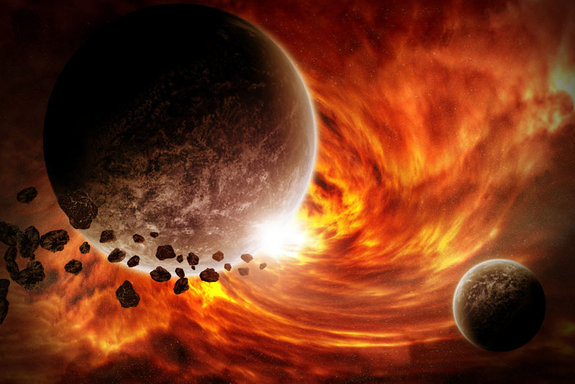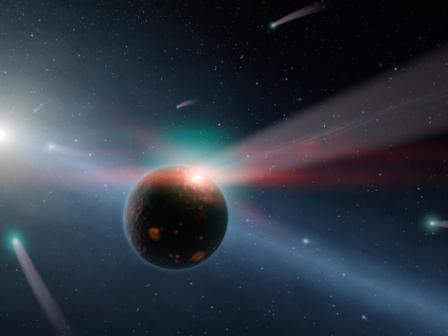Whether their book was based upon
a solid set of scientific assumptions or not, it can now be seen to be seriously
flawed. Videos and other supporting evidence posted on the Internet over
the last few years has claimed that images of sundogs and lens flares around the
Sun prove that Planet X is upon us. It does not. They simply prove
that some images taken of the Sun have lens flares and sundogs. For their book
to have been correct, we are now at the stage when a second sun should be
clearly visible. It is not. There's no getting around this now.
A brown dwarf object closer than Jupiter would be a highly visible night-time
object - certainly the brightest object in the night sky after the Moon.
So where is it?
Now is the time for an earnest
debate on this subject. There are many, many people who, influenced by the
Planet X Forecast and other similar missives, still believe that the end of the
Mayan Calendar augurs the catastrophic return of Nibiru. They are anxious,
even fearful of this outcome. I want to put their minds at rest.
I don't know what the end of 2012 will bring, but I know what is
not going to happen - we will
not see catastrophe at the hand of a
brown dwarf closing in on perihelion. Those still arguing that this might
happen risk creating unnecessary panic and anxiety in a public already rocked by
economic turmoil. They should recognise their error. The 2012 scenario has,
predictably, caused the Planet X debate severe damage. NASA has been
bombarded with questions from fearful members of the public, creating a feeding
frenzy of scepticism that has damaged more considered arguments for the
existence of another distant planet in our solar system. The public
now perceive the claim for a Planet X body as being the hallmark of cranks.
I was right to argue against the
2012 scenario back in 2006, and I stand by the criticism I levelled at the
Planet X Forecast book back then. That's my opinion as a researcher, but I also
recognise that others have differing opinions. If they want to share them
with me then I'm happy to hear them and include their points here on my website.
I want the public to be able to access an honest, open debate on this subject as
minds increasingly turn to this year's winter solstice.
Written by Andy Lloyd, 6th January 2012
Lee Tierney writes (8 January 2012):
"I have just enjoyed your
latest post and I agree, the biggest immediate threat to people are the
Global Government(s).
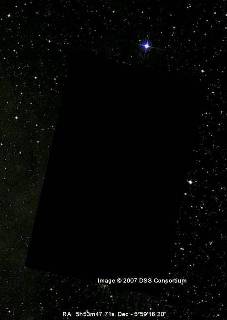
However, I have probably trawled every
image and video on the web searching for 'THE' dwarf star and I keep going
back to the Google Sky image that was removed (2007 ?) and replaced
with a dark rectangle. If this was a hoax why would Google
censor the area in question or do they like playing mind games....?"
Lee
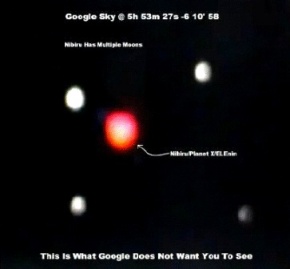
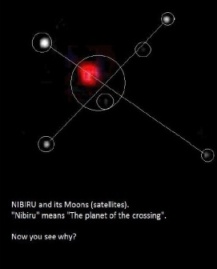
Andy replied (8 January 2012):
"Thanks for sending these
images through. I'm not sure why Google left a gap in the full sky
survey - it may be an artifact of overlapping plates that missed a bit, or
it may be to cut out an overly bright object. Or it may be to hide
something they don't want anyone to see. But I'm also not clear on the
provenance of the image of Nibiru/Planet X and its moons, which are just as
likely to have been created by someone in photoshop/paintshop.
"They don't look authentic to me, and fakery here is a likely possibility.
Of course, just because someone might have opportunistically faked these
images doesn't mean that there isn't something else genuine to see that's
been censored. But...if that's the case, it's a very, very long way
out, and it is certainly the case that for Marshall Masters et al to be
right we should all be able to see this object clearly in the night sky now.
That is self-evidently not the case."
Andy
For more details see:
darkstar1.co.uk/googleearth.html
Lords of the Underworld
No one really knows what the
Mayans thought would happen when their long-count calendar comes to the end of
its 5,125 year cycle on 21st December of this year. Even within academia
there is a wide difference of opinion, from earlier Mayanists who considered the
date to be an indication of the End of an Age, with apocalyptic undertones (1),
to more modern commentators who are generally dismissive of it meaning anything
beyond ritualistic significance. The modern Maya themselves seem
unworried, and no doubt welcome the global interest in their culture that this
year will bring.
The date signifies the calendar
round of the 13th Baktun (13.0.0.0.0 in Mayan's complex long-count system).
Seemingly, only one inscription from ancient Mayan culture concerning this date,
now imminent, survived the purges of the Conquistadors. This partially
defaced inscription is found on Monument 6 at Tortuguero, Mexico. Here are
two translations of the same inscription:
"It will be completed the 13th b'ak'tun. It is 4 Ajaw 3 K'ank'in and it
will happen a 'seeing'[?]. It is the display of B'olon-Yokte‘ in a
great [investiture].” (2)
“At the next creation, the Bolon Yokte Ku, or Nine Support Gods, will
[return].” (3)
So, it's clear
that the ‘Bolon Yokte K’uh’ are scheduled to make an appearance
on 21st December 2012. They are the Nine Lords of the
Underworld and - depending on who you think is closer to the
truth with their interpretation - they will return/descend/be
invested as a deity in a Mayan ceremony on the date of the
completion of the 13th Baktun. Is this good or bad, or just
myth? The Nine Gods of the Underworld (sometimes
considered to be a single deity) will apparently conquer the
Thirteen Gods of Heaven. The victorious Nine will then decide on
the fate of the next (Fifth) Age.
Perhaps many years
ago one might have reasonably argued that the Bolon Yokte K’uh
referred to a returning planet or planetary system, like
the Dark Star Nibiru achieving perihelion in its long elliptical
orbit around the Sun. Then this conflict might have
referred to some kind of celestial battle within the solar
system. But, as we can see in my next article below, that
has not been possible for some years now: Planet X simply
has not made an appearance.
Others wonder
whether the Bolon Yokte K’uh are linked with another 'Nine'.
Channellers and psychics claim contact with powerful
extraterrestrial entities known as "The Nine" - notably the
maverick researcher Dr Andrija Puharich and his co-workers (4).
He equated 'The Nine' with the Nine Principles in ancient
Egyptian belief, known as the Ennead. The ancient
Egyptians referred to them as "Nine that are One" (5), eerily
reminiscent of the Mayan 'Bolon Yokte K’uh' whose
plurality/singularity is also ambiguous.
Now compare the
rather scant description of the Mayan Nine Gods of the
Underworld with the Sumerian deities, the Anunnaki: “those
who from heaven came to earth”. In Middle Babylonian times
the term Anunnakku (Anuna) also referred to the Gods of the
Underworld. Are we talking about the same extraterrestrial
entities, the descriptions of which vary over three ancient
cultures? According to Zecharia Sitchin, the Anunnaki were
flesh-and-blood gods who colonised the Earth in the ancient past
(6). They come from the planet Nibiru, which is synonymous
for many with Planet X, and Sitchin argued that they had a
significant impact on the emerging cultures of South and Meso-America
(7).
Just because their
planet (in whatever guise it takes) has not turned up as some
predicted, it does not mean to say that the Anunnaki themselves
might not drop by - thus fulfilling their promise to the ancient
Maya?
Written by Andy
Lloyd, 17th January 2012
References:
1) Michael D. Coe
"The Maya. Ancient peoples and places series" 52 London: Thames and
Hudson 1966
2) Inscription
translation by Sven Gronemeyer and Barbara MacLeod, "What Could Happen
in 2012: A Re-Analysis of the 13-Bak'tun Prophecy on Tortuguero Monument
6", University of Copenhagen: European Association of Mayanists, 34:
1–68, 2010
3) Philip Coppens
"The Ancient Alien Question" p255, New Page Books 2012
4) Andrija Puharich,
"The Sacred Mushroom: Key to the Door of Eternity" Gollancz 1959
5) Lynn Picknett &
Clive Prince "The Stargate Conspiracy", p182, Warner 1999
6) Zecharia Sitchin
"The Twelfth Planet" Avon 1976
7) Zecharia Sitchin
"The Lost Realms" Avon 1990
Planet X
Nibiru Conference, Rome 29th January 2012

Andy Lloyd was the keynote speaker
at the "Planet X Nibiru Conference" in Rome, on Sunday 29th January 2012 -
organised by Massimo Fratini. Devoted to the subject of Planet X Nibiru
and 2012, Andy had been invited to return to Rome to discuss the very latest
news about the hunt for Planet X, as well as whether the end of the Mayan
Calendar will bring forth catastrophe from the sky. Other speakers
included Massimo Fratini, Enrico Baccarini, Mauro Biglino and Ivan Ceci.
Here's Andy's review, with images
from the conference and Rome:
darkstar1.co.uk/roma.html
A Steppenwolf
Planet?
Could life exist on a planet in
the outer solar system that is not warmed by a brown dwarf? This is a
critical question for Zecharia Sitchin's "12th Planet Theory". Even towards the
end of his life, he maintained that it was possible: That the atmosphere of
Nibiru would be warmed internally by geothermal and radioactive activity within
the planet. I argued against this possibility - the Nibiruan atmosphere
would simply become mile-high sheet of volatile ices spread evenly across the
planet's surface. Which, of course, would be incompatible with life.
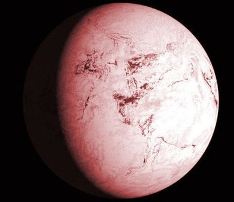
Well, scientists have recently
become interested in this very question, and have modelled circumstances in
which a sub-glacial ocean might exist on a 'rogue' planet too far from the Sun
to be warmed by it. Here's the abstract of a paper by Dr Abbot (a
geophysicist) and Dr Switzer (an academic astrophysicist):
"We investigate the possibility
that a rogue planet could maintain a liquid ocean under layers of thermally
insulating water ice and frozen gas as a result of geothermal heat flux. We find
that a rogue planet of Earth-like composition and age could maintain a
subglacial liquid ocean if it were ≈3.5 times more massive than Earth,
corresponding to ≈8 km of ice. Suppression of the melting point by contaminants,
a layer of frozen gas, or a larger complement of water could significantly
reduce the planetary mass that is required to maintain a liquid ocean. Such a
planet could be detected from reflected solar radiation, and its thermal
emission could be characterized in the far-IR if it were to pass within O(1000)
AU of Earth." (1)
This would have given Mr Sitchin
some succour, I think. However, I think it's fair to point out that were life to
exist on such a world, it would be living beneath 8 kilometres thickness of
ice! Which is not exactly the scenario he had in mind for his Anunnaki.
But, the bigger the planet, the less of an icy shield would be required to
create this Europa-type world in the outer solar system. And Sitchin's
planet, as we know, is supposed to be very massive. So, food for thought.
Written by Andy Lloyd, 14th
February 2012
1) D. S. Abbot and E. R. Switzer
"The Steppenwolf: A Proposal for a Habitable Planet in Outer Space"
The
Astrophysical Journal Letters, 735: L27, July 10 2011, with thanks to
Lorenzo
iop.org article
The
Free-Floating Planet Solution
It has become apparent in recent years that
interstellar space contains a very large number of free-floating planets, or
FFPs (unfortunately, the same acronym as Fresh Frozen Plasma, which will only
serve to befuddle my health professional brain!) These FFPs are not orbiting
around stars, but are plunging through the depths of inter-stellar space, and
many of them are giant planets - Dark Stars using my obscure nomenclature. Where
did they come from? Likely, they were expelled from the fledgling stellar system
they first formed in, knocked out of their planetary nest by a gravitational
thrust, perhaps caused by a near-miss with a neighbour, for instance.
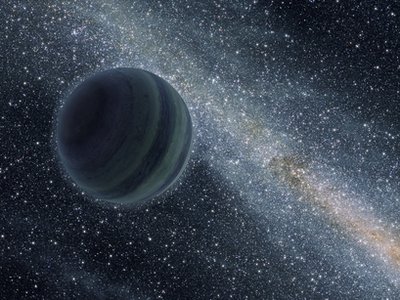
Now, scientists are tying these objects up with the additional discovery of wide
binary objects - massive planets, sometimes brown dwarfs, which are found
orbiting their companion star at such a great distance that it seems unlikely
that they could have formed at that position in the first place by the standard
model of planet-formation. They have to have got there somehow, though, and
capture is now considered an increasingly likely possibility, despite the
immense distances between stars.
It seems as though the galaxy is a lot more dynamic than astronomers first
thought. Where initially they thought all the galaxy's planets would have formed
alongside their stars, and been protected by them, it is now realised that
things are a lot more complex. Planets seem to come and go, migrating out of one
system and finding themselves then migrating into another. Consequently, for the
first time, astronomers have started trying to put some numbers to these events
- to come up with some probabilities. Work done by Hagai Perets of the
Harvard-Smithsonian Center for Astrophysics in Cambridge, Massachusetts, and
Thijs Kouwenhoven of the Kavli Institute for Astronomy and Astrophysics at
Peking University, Beijing indicates that the chances of any star capturing an
FFP is reasonable (1), and not, as previously thought, vanishingly small.
"In recent years several planets have been discovered at wide orbits (>100 AU)
around their host stars. Theoretical studies encounter difficulties in
explaining their formation and origin. Here we propose a novel scenario for the
production of planetary systems at such orbits, through the dynamical recapture
of free floating planets (FFPs) in dispersing stellar clusters." (2)
The implication is that even a star like our own Sun might have captured a
massive FFP - one that, perhaps even now, might be found orbiting among the
comets in the Oort Cloud.
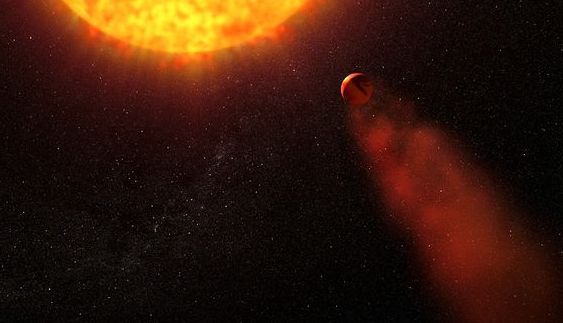
Until recently, such a
possibility was considered extremely far-fetched. I
remember the late Tom van Flandern railing against
the idea that the planet Nibiru might have been
captured by the Sun. The possibility was
statistically negligible, he argued, damning
Sitchin's theory in so doing. Many other sceptics
down the years, have argued the same, putting off
many open-minded people from realising that the
existence of a Planet X body could be a distinct
possibility. Yet, now we have a reasonable chance
that such a capture scenario might indeed have
happened.
So what's changed? Well, the sheer number of FFPs
has surprised astronomers (3), which raises the
likelihood of Sitchin's scenario being a real
possibility. Additionally, there's also the fact
that many stars - ours included, perhaps - form in
stellar nurseries: hot-beds of stars popping up in
clumps, like seedlings in a Spring garden that need
thinning out and planting elsewhere. That gardening
metaphor seems very apt: planets can be tossed from
one star to another within this dense patch during
the early spring chaos. That may create some
interesting scenarios, according to new computer
simulations:
"Because most stars are
born with others, Perets and Kouwenhoven ran
computer simulations to see what happens when a star
cluster contains free-floating planets. If the
number of free-floating planets equals the number of
stars, then 3% to 6% of the stars succeed in
capturing a planet, and some stars capture two or
three. Most of the captured planets end up hundreds
or thousands of times farther from their stars than
Earth is from the sun. Furthermore, most captured
planets have orbits tilted to those of native-born
planets, and half the captured planets revolve
around their stars backward." (4)
So, here we have the possibility of massive
loosely-bound captured planets exhibiting retrograde
orbits and tilted planes compared to their
home-grown siblings. Where have we heard this
before? It sounds remarkably like the scenario
proposed by Zecharia Sitchin - long before FFPs were
anything other than simple blood products! And given
that many of these FFPs are Dark Stars, it seems
that the scenario that has been put forward on this
very website over the last 13 years is moving one
step closer towards some kind of reality. Because,
as discomforting as this may be for many, the
indirect evidence for the existence of another
massive planet somewhere in the solar system is
growing by the year, as can be noted from the
various items posted in these Dark Star news pages.
Written by Andy Lloyd,
22nd February 2012
References
1) Ken Croswell "Some
Planets Are Alien Invaders" 21 February 2012
science.org article
2) Hagai B. Perets, M. B. N. Kouwenhoven
"On the origin of planets at very wide orbits from
re-capture of free floating planets" The
Astrophysical Journal, 750(1) 17 April 2012
iop.org article
3) Nancy Atkinson
"‘Nomad’ Planets Could Outnumber Stars 100,000 to 1"
23 February 2012, with thanks
to Lee
universetoday.com article
4) Alasdair Wilkins
"There really could be a giant planet hidden far
beyond Pluto" 21 February 2012,
with thanks to David
gizmodo.com article
Water Planet May
Hold the Secrets of Tiamat
Scientists have discovered an
extra-solar planet, larger than Earth, almost entirely made up of water. They
were able to look at the spectrum of light from the planet's atmosphere - a
planet which lies very close to its parent red dwarf star. That spectrum showed
water - lots of it. And because the astronomers have good data on the planet's
other properties, they were able to discern that this was indeed almost entirely
a watery world:
"Since the planet's mass and size are known,
astronomers can calculate the density, of only about 2 grams per cubic
centimetre. Water has a density of 1 gram per cubic centimetre, while Earth's
average density is 5.5 grams per cubic centimetre. This suggests that GJ 1214b
has much more water than Earth does, and much less rock. As a result, the
internal structure of GJ 1214b would be extraordinarily different from that of
our world.
"The high temperatures and high pressures would form exotic materials like 'hot
ice' or 'superfluid water', substances that are completely alien to our everyday
experience," [Zachory] Berta [of the Harvard-Smithsonian Center for
Astrophysics] said. Theorists expect that GJ 1214b formed further out from its
star, where water ice was plentiful, and migrated inward early in the system's
history. In the process, it would have passed through the star's habitable zone,
where surface temperatures would be similar to Earth's. How long it lingered
there is unknown." (1)
The last part of the above quote is particularly interesting to me. Those of us
interested in Zecharia Sitchin's theories are familiar with his proposition that
Earth was once a larger, more watery world lying where the Asteroid Belt is now.
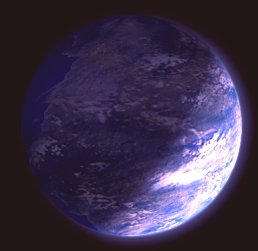
Sitchin proposed that this primordial planet, the mythological Tiamat of the
Babylonian Epic of Creation the Enuma Elish, was battered by a moon of Marduk
(the rogue interloper, or Dark Star) and migrated in to a closer orbit around
the Sun (an event likely to be during the Late Heavy Bombardment 3.9 billion
years ago (2)). The remains of Tiamat were thus distributed as Earth and the
Asteroid Belt.
What a fascinating parallel with the extra-solar planet GJ 1214B! This planet is
also made up primarily of water, and migrated in towards its star, passing
through the star's habitable zone.
Andy Lloyd, 29th February 2012
References:
1) "In distance space [sic],
a water world: Hubble reveals a new class of extrasolar planet" 21 February
2012,
with thanks to Theo, et al
phys.org news
2) "Asteroids Smacked Moon
Stronger & Faster 4 Billion Years Ago" 28 Feb 2012,
with thanks to Lee
space.com article
Scientists Also
Now Think the
Earth Migrated
Migration of planets is the new zeitgeist. Academic astronomers and science commentators are fighting an increasingly rearguard action to fend off the accusation that new theories of solar system formation are sounding ever more Sitchinite. Why? Because the solar system appears to be a far more complex beast than the old theories allowed, and discoveries in other extra-solar planetary systems indicate the central importance of catastrophism. Many astronomers now believe that star systems kick out planets routinely during their formation, and also, due to the subsequent abundance of free-floating planets, draw new planets in.
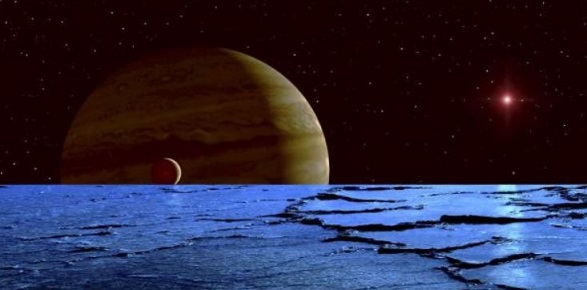
Well, that whole concept is equal in every way to Sitchin's theory from 1976. And now we're moving one step closer towards a union of science and Sitchin, as Earth's origins themselves are considered:
""Planets don't like to stay still, they like to move," said David Minton of Purdue University at the Space Telescope Science Institute in Baltimore, Md., on April 10. This is proven by the discovery of hundreds of extrasolar planets that reinforce a radical new idea that would have never even been considered in the 1950s: Planet migration seems the rule rather than the exception among the stars. This explains the estimate of billions of "hot Jupiters," which are predicted to have moved to orbits precariously close to their stars - to the point of evaporating away. More recent discoveries find pure water planets that must have migrated in toward their sun as ice balls." (1)
As my friend Lee succinctly put it, "This fella has it ass-backward, but it shows they're trying to understand why Earth is where it is" (2). What he means by this is that the David Minton thinks the Earth migrated from a more inner location, whereas we think there is strong evidence that the opposite is true, i.e. that Earth migrated after a catastrophic event from the region of the asteroid belt. But the underlying principle is the same. And if the conservatives in the science community feel uncomfortable with all this, then it's tough. If facts move us in the direction of Sitchin's Nibiru being a real possibility, then they should be open to that, no matter what their prejudices may allow.
Andy Lloyd, 21st April 2012
References
1) Ray
Villard
"Was
Earth a
Migratory
Planet?"
18
April
2012,
with
thanks
to Lee
seeker.com
article
2)
Correspondence
from Lee
Covino,
20
April
2012
Astronomers
Consider a Massive Planet X Solution
The anomalous orbits of several Kuiper Belt
Objects have caused another prominent astronomers to speculate on the existence
of a massive Planet X:
"An as yet undiscovered planet
might be orbiting at the dark fringes of the solar system, according to new
research. Too far out to be easily spotted by telescopes, the potential unseen
planet appears to be making its presence felt by disturbing the orbits of
so-called Kuiper belt objects, said Rodney Gomes, an astronomer at the National
Observatory of Brazil in Rio de Janeiro.
"What's intriguing, Gomes said,
is that, according to his new calculations, about a half dozen Kuiper belt
objects—including the remote body known as Sedna—are in strange orbits compared
to where they should be, based on existing solar system models. The objects'
unexpected orbits have a few possible explanations, said Gomes, who presented
his findings Tuesday at a meeting of the American Astronomical Society in
Timberline Lodge, Oregon. "But I think the easiest one is a planetary-mass
solar companion"—a planet that orbits very far out from the sun but that's
massive enough to be having gravitational effects on Kuiper belt objects."
Other astronomers are
intrigued but say they'll want a lot more proof before they're willing to agree
that the solar system—again—has nine planets.
(1)
Gomes is sticking his head on the block with this. I suspect the general
position for astronomers interested in the outer solar system is this: the
evidence is shifting fairly rapidly towards there being a massive outer planet
in a strange, elongated orbit around the Sun. The two major factors
increasing the probability of this are (a) anomalies in the outer solar system
which indicate the presence of a perturbing object and (b) the increasing
evidence of a vast swath of rogue, dark planetary objects in interstellar space,
to the extent that these old, cold brown dwarfs might even account for the
galaxy's missing mass (2). Given the statistics of this kind of scenario,
in my opinion, it would now be odd if the Sun didn't
have a companion object. I suspect the vast majority of stars have binary
companions, whether stellar or dark.
Astronomers still don't want to be associated with the Planet X/Nibiru debate,
for fear of destroying their academic reputations. Dr Gomes is breaking
away from the pack, as several other astronomers have done before him. I
applaud that, but it's also interesting to see the measured, sceptical response
levelled at him by his peers. They haven't exactly ripped into him, but
they're clearly reticent about supporting this move without a great deal more
direct evidence of this unseen companion. But instead of a knee-jerk
wholly negative reaction to this new claim for a massive Planet X, I sense that
they're hedging their position, which is very encouraging...
Andy Lloyd, 15th May 2012
References
1) Richard Lovett "New Planet Found in Our Solar
System?" 11 May 2012,
with thanks to David who submitted this article to the
Dark Star Discussion Group.
nationalgeographic.com article
2) Eddie Wrenn "Could billions upon billions of
free-floating 'nomadic' planets in the Milky Way be seeding our galaxy with
life?" 11 May 2012,
with thanks to Mart
dailymail.co.uk article
WISE spots less
neighbouring Brown Dwarfs than hoped
The first findings of WISE's search for brown
dwarfs near to the Sun have been released. They appear to show less than
expected within 26 light years, although that's still a fair few at over 30.
"Astronomers
are getting to know the neighbors better. Our sun resides within a spiral
arm of our Milky Way galaxy about two- thirds of the way out from the center. It
lives in a fairly calm, suburb-like area with an average number of stellar
residents. Recently, NASA's Wide-field Infrared Survey Explorer, or WISE,
has been turning up a new crowd of stars close to home: the coldest of the brown
dwarf family of "failed" stars.
"Determining the distances to these objects is a key factor in knowing their
population density in our solar neighborhood. After carefully measuring the
distance to several of the coldest brown dwarfs via a method called parallax,
the scientists were able to estimate the distances to all the newfound brown
dwarfs. They concluded that about 33 brown dwarfs reside within 26 light-years
of sun. There are 211 stars within this same volume of space, so that means
there are about six stars for every brown dwarf.
""Having
fewer brown dwarfs than expected in our celestial backyard just means that each
new one we discover plays a critical role in our overall understanding of these
cold objects," said Chris Gelino, a co-author of the new research who is also at
the Infrared Processing and Analysis Center. "These brown dwarfs are fascinating
objects that are bridging the gap between the coldest stars and Jupiter."
Kirkpatrick emphasized that the results are still preliminary: it is highly
likely that WISE will discover additional Y dwarfs, but not in vast numbers, and
probably not closer than the closest known star, Proxima Centauri. Those
discoveries could bring the ratio of brown dwarfs to stars up a bit, to about
1:5 or 1:4, but not to the 1:1 level previously anticipated."
(1)
I guess if we're honest, on the
face of it this isn't terribly good news - statistically, at least, the
potential for a solar system sub-brown dwarf companion is a little lower than it
was, say, 6 months ago.
But... spotting these objects is more complex than the article perhaps allows
for, although it's clear that Dr Kirkpatrick is entirely aware of this.
There are a great many objects out there with IR signatures that WISE will have
picked up. Finding a BD very close to us involves both the discovery of a
signature heat source, but also, and more importantly, the perception of
movement of that source over a six month period. Given the short
shelf-life of the WISE telescope, then making those parallax measurements
consistently for all data points is bound to be a less than perfect procedure.
Matese et al have already alluded to this potential for a short-fall in BD
discoveries with WISE, effectively raising the possibility of a false negative
(2).
Also bear in mind recent speculation by some serious astronomers that BDs might
be extremely numerous across the galaxy, particularly as dark interstellar
objects, and we have an inconsistent picture emerging - both a high number
generally, but a low number locally. This paradox may indicate that WISE
has not picked up everything out there that it should have, and not just the
Y-Dwarfs as described above. If the Sun has a companion object, it is
likely to be one of these ultra-small sub-brown dwarfs - the so-called Y-dwarfs.
So WISE may yet come up with the goods, even if the statistics are leaning
against it.
Andy Lloyd, 12th June 2012
References
1) "WISE finds few brown dwarfs
close to home" 8 June 2012, with thanks to David and Mart
phys.org news
2) John Matese & Daniel
Whitmire "Searching the WISE Preliminary Catalog for Massive Planets in the
Solar System" EPSC-DPS Joint Meeting 2011, Nantes, France, 2-7th October 2011,
ucs.louisiana.edu pdf
The Syrian Connection
Author and Sitchinite researcher
Michael Tellinger has written extensively about the mystery of the ancient stone
enclosures spread widely across the southern African landscape (above left).
He has made connections with Sitchin's description of this area's importance to
the Anunnaki, particularly in terms of gold mining.


Well, it appears that these same
mysterious structures appear elsewhere, this time in the Middle East's Syrian
Desert (above). Read more about the connection here, accompanied by
the usual mind-wrenching dose of speculation:
The Syrian Connection
Late, Great Bombardment Event
Seen Affecting Nearby Star System
Planets form
around Binary Systems
One of the arguments levelled
against the possibility that our Sun might have a distant binary companion is
that the planetary system would not have formed under such conditions.
Simply put, the dual 'star' system would be too complex to allow a relatively
stable system of planets to form, like that observed in our own solar system.
Part of the reason for that position is the traditional model of how planets
form in the first place. But there's also the question of the dynamics of
such a complex system, and how the orbits of planets would be perturbed by such
complexity over time. That issue includes the 'Kosai' effect, which might
limit the parameters for a binary sub-brown dwarf companion.
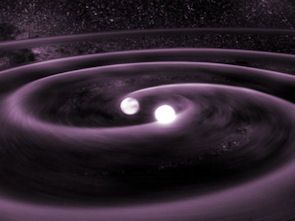
Well, that whole position is now
brought into question by the discovery of a planetary system around a distant
binary star system in the Cygnus constellation. Remarkably, one of the
planets discovered there, orbiting two suns, is in their 'habitable zone'.
But amazing as that is, that is not the main repercussion of this discovery.
Instead, the whole theory of planet formation - already rocked by so many
bizarre extra-solar planet discoveries - finds itself in urgent need of
reformation:
"The presence of a full-fledged circumbinary planetary
system orbiting Kepler-47 is an amazing discovery," said Greg Laughlin,
professor of Astrophysics and Planetary Science at the University of California
in Santa Cruz. "These planets are very difficult to form using the currently
accepted paradigm, and I believe that theorists, myself included, will be going
back to the drawing board to try to improve our understanding of how planets are
assembled in dusty circumbinary disks." (1)
Further, the potential for our own
Sun to have had a brown dwarf companion at some point in its history - as hinted
at by many experts on the outer solar system - is enhanced by this finding.
Indeed, I wonder whether the perturbing influence of a double stellar system is
actually required to create the lumps of accreting matter in the
proto-planetary disks from which planets form. I wonder whether one day we
might consider the traditional model of massive planets somehow forming out of a
unperturbed, uniform disk to have been a rather quaint concept, but one that
was, in hindsight, totally misguided. Instead, it is the influence of the
companion, notable in most star systems, that allows for the creative tension in
the planet-forming disk of matter common to both 'stars'. And by stars, we
can mean stellar bodies right down to the sub-brown dwarf companion that might
be our own Dark Star.
Written by Andy Lloyd, 5th
September 2012
Reference:
1) "Binary Star Systems may be
'Hot Zones' for Life - New NASA Discovery" 4 September 2012, with thanks to
Lee (article no longer available online)
Rogue Planet Identified
Astronomers have confirmed the existence of a
distant rogue planet moving through interstellar space. Although it does
not appear to be attached to a star system, it is accompanied by a cluster of
stars moving in a similar direction. Yet, it is independent of them, leading to
a number of question about its provenance (1).
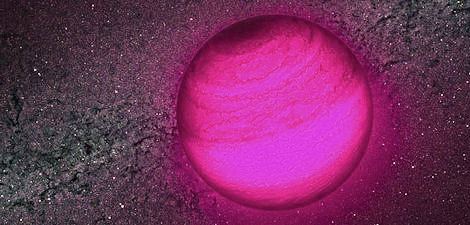
This is the first concrete discovery of a rogue
planet drifting through space, in gas giant/brown dwarf category. In itself, it
confirms the potential for many such objects moving pretty much
independently through interstellar space. This is important for people
considering the likelihood of Sitchin's Twelfth Planet theory because it
confirms that not only do rogue planets of great size exist, but that they
perhaps exist in sufficient numbers to make the chances of an incursion into a
star's planetary zone a non-negligible possibility. In other words, it boosts
the chances that he was right when he proposed back in 1976 that a rogue planet
might find its way into the solar system - up until very recently astronomers
discounted this as practically impossible. They were wrong.
I heard about this discovery on the news last night on BBC radio. I knew that
this must be a sub-brown dwarf, of the category of a 'Dark Star'. Yet, the term
brown dwarf was not used at all (2). They ended up calling it a 'Lonely
Planet'. Rather poetic, to be sure, but it did make me wonder whether the term
brown dwarf has become toxic among astronomers, who fear immediate association
with Nibiru/Planet X etc.
Written by Andy Lloyd, 15th
September 2012
References:
1) ESO "Lost in Space:
Rogue Planet Spotted?" eso1245 Press Release, 14 November 2012 with thanks to David
eso.org news
2) "The World Tonight" BBC Radio 4, 13 November 2012
Sun's Sibling Tilted the
Earth's Orbit
Anomalies in the orbits of the planets, including
Earth, have been one of the main arguments for a second sub-stellar body in the
solar system. Potentially helpful to these arguments is the paper just
published by astronomer Konstantin Batygin,
of the Harvard-Smithsonian Center for Astrophysics in Cambridge, Massachusetts
(1) which proposes that companion stars might be responsible for the way
planetary orbits are often titled away from the stellar equator. In the
Sun's case, its planetary system is misaligned to its own plane of spin by
7 degrees.
Astronomers have been studying extra-solar
planetary systems containing Hot Jupiters, and it was initially thought when
these strange planets were first discovered that their migration patterns caused
the entire planetary systems they moved through to tilt. But that argument
has become more complicated by the discovery of even weirder Hot Jupiters, which
themselves exhibit tilted and even retrograde orbits (2). Something else
is evidently causing these remarkable tilts. And given that the Sun's own
system is also tipped, then that mechanism has repercussions for our own system
(3).
The new theory recently offered brings to bear the
gravitational influence of sibling stars born alongside the star in question. As
stars are often born in clusters, the proximity of a nearby star in the cluster
can cause the tilting of a star's fledgling planetary system.
""Misaligned orbits are
actually a natural outcome of disk migration—once you take into account the fact
that planetary systems are usually born in multistellar environments," [Batygin]
says, noting that many stars have stellar companions..."I think somewhere in the
Milky Way, there's a star that's responsible for tilting us." He suspects the
sun once had a companion star that tipped the solar nebula by 7°, then fled the
scene after the planets arose." (4)
Once again, we are confronted with the need for a
massive companion combined with the lack of companion itself. While it
remains quite plausible that a companion star has indeed moved away from the Sun
long ago, it is also surely possible that the same effect might have been
achieved through the action of a sub-stellar companion, like a sub-brown dwarf.
Indeed, the very notion that Hot Jupiters might have had sufficient influence to
have tipped distant planetary systems lends credibility to such an idea.
When we consider clusters of stars forming
together, we also have to allow for many of those stars being dwarf stars, right
down to just a few Jupiter masses. Therefore, the tipped orbits of the
planets around the Sun might also have been caused by a rogue brown dwarf
object. And, given how difficult these things are to detect, its possible
that the fellow responsible is still hanging around out there...
Andy Lloyd, 18th November 2012
References:
1) Konstantin Batygin "A primordial origin for
misalignments between stellar spin axes and planetary orbits" 15 November 2012
nature.com article
2)
Daily Mail, "Backwards galaxy: First planet found that orbits in opposite
direction to its star", 14 August 2009,
dailymail.co.uk article
3) Damien
Gayle "Did a lost star knock the Earth off its orbit?
New theory to explain why our planet circles the sun at
an angle to the solar equator?" 16 November
2012,
thanks to David
dailymail.co.uk article
4) Ken
Croswell "Did a Lost Star Torque Earth's Orbit?" 14 November 2012, with thanks to Lee
science.org article
Bond vs Bainbridge

One or two scenes from the new Bond movie Skyfall
are eerily reminiscent of scenes from my novels, and Bond has transmuted towards
Bainbridge. Judge for yourself:
Skyfall and my novels
Rocky Worlds can form around
Brown Dwarfs
Naysayers in the astronomical community who have
doubted that rocky planets like Earth and Mars can form around brown dwarfs have
been forced to reconsider. The minute building blocks of planets appear in
protoplanetary disks around normal suns, in the form of millimetre-sized grains
orbiting en masse around the fledgling star.
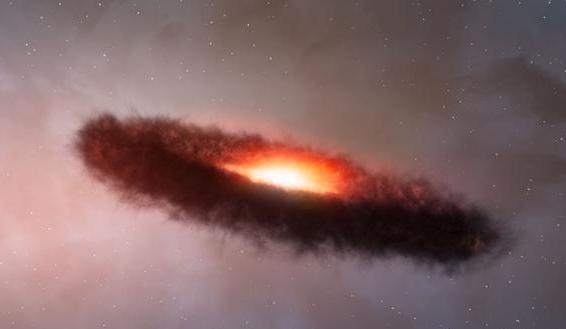
They are then thought to
accrete together, coalescing into planets as the developing clumps take on
sufficient gravitational power to sweep up the matter around them. But
scientists were doubtful that the building blocks for this process could form
around much smaller 'stars', like brown dwarfs. But now a new study has
revealed a protoplanetary disk around a brown dwarf which resembles that of
regular stars (1).
""We were completely surprised
to find millimetre-sized grains in this thin little disc," said Luca Ricci of
the California Institute of Technology, USA, who led a team of astronomers based
in the United States, Europe and Chile. "Solid grains of that size shouldn't be
able to form in the cold outer regions of a disc around a brown dwarf, but it
appears that they do. We can't be sure if a whole rocky planet could develop
there, or already has, but we're seeing the first steps, so we're going to have
to change our assumptions about conditions required for solids to grow," he
said.
"In the near future, the
completed ALMA telescope will be powerful enough to make detailed images of the
discs around Rho-Oph 102 and other objects. Ricci explained, "We will soon be
able to not only detect the presence of small particles in discs, but to map how
they are spread across the circumstellar disc and how they interact with the gas
that we've also detected in the disc. This will help us better understand how
planets come to be.""
(2)
For me, this is an exciting prospect, offering us
the first real glimpse of how planets might form around dwarf stars like brown
dwarfs, and perhaps in time even smaller objects, like sub-brown dwarfs.
This might then provide insight into how a binary object orbiting the Sun could
have developed its own rocky planet system at such a great distance from the
heat of the Sun itself.
Written by Andy Lloyd, 1st December 2012
References:
1) L. Ricci, L. Testi, A. Natta, A. Scholz
and I. De Gregorio-Monsalvo. "ALMA observations of ρ-Oph 102: Grain growth and
molecular gas in the disk around a young brown dwarf" Astrophysical Journal
Letters, 761(2): L20, November 2012
iop.org article
2) European Southern Observatory
"Even brown dwarfs may grow rocky planets: Sizing up grains
of cosmic dust around failed star" 30 November 2012 with thanks to Scott and Lee
sciencedaily.com article
Beyond 2012
As widely predicted, the world did not come to an
end on 21st December 2012. Yay. While I'm sure that many a
modern-day Mayan will be enjoying the festivities of welcoming in the 14th
Baktun, there will be many New Age folk wondering what happened. Just as
the end of the second millennium after the birth of Christ did not herald an
apocalypse, or even a technological meltdown, so did the turning of the Mayan
calendar not bring forth the fires of hell for humanity. This much we
know. What we still don't know is why the beginning of the Mayan calendar
was set over five millennia ago, long before the Mayan civilisation itself got
into its stride. What event in their own prehistory set forth that great
rolling stone of time that has now successfully completed its 13th revolution?
Perhaps we may never find out. But given the
lack of an obvious astronomical event to coincide with this year's winter
solstice, it does not appear to reflect a prediction of a return of anything,
certainly not Nibiru. Indeed, it has to be said that amalgamating the
Mayan calendar and the return of Nibiru was always problematic. After all,
the concept of Nibiru is to be found in the early writings of Mesopotamian
cultures, whereas the Mayans appear to have been a purely American civilisation,
untouched by the Old World. Only if they were influenced by a common
precursor could one really connect the two, and the evidence for that is scant
(although, controversially, it may actually exist).
More likely, then, the connection between Nibiru
and 2012 was one of 'common sense' - at least within an alternative, New Age
context. The connection brought together the ending of a long Age and the
return of a long-period planet, both of which might ring the alarm bells of
imminent destruction. It is clear why such a concept captured so many
people's imaginations. The problem was always the lack of any kind of
evidence underlying this connection, beyond reference to an ancient Celtic text
whose own provenance is, at best, questionable.
Has the hunt for Planet X been damaged by the 2012
connection over the course of the last decade? Undoubtedly - although that
should be balanced against the clear raising of awareness of the issue of a
rogue, returning planet among the general population who might never have heard
of Nibiru otherwise. Whether any might go on to ponder the merits of the
case for a significant undiscovered planet in the solar system remains to be
seen. I hope they do, because there is still a case to answer.
Written by Andy Lloyd, 21st December 2012

